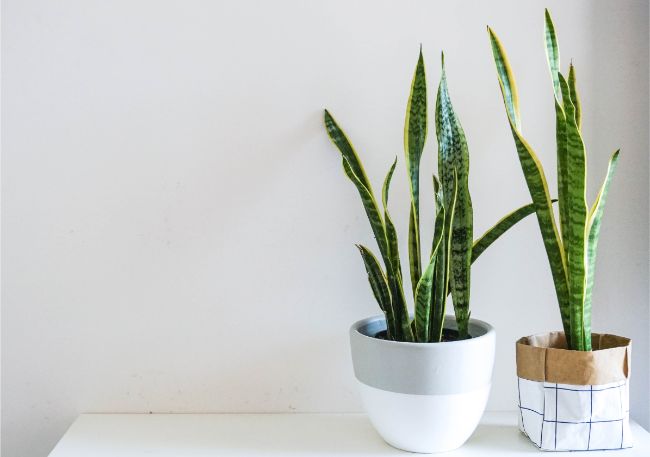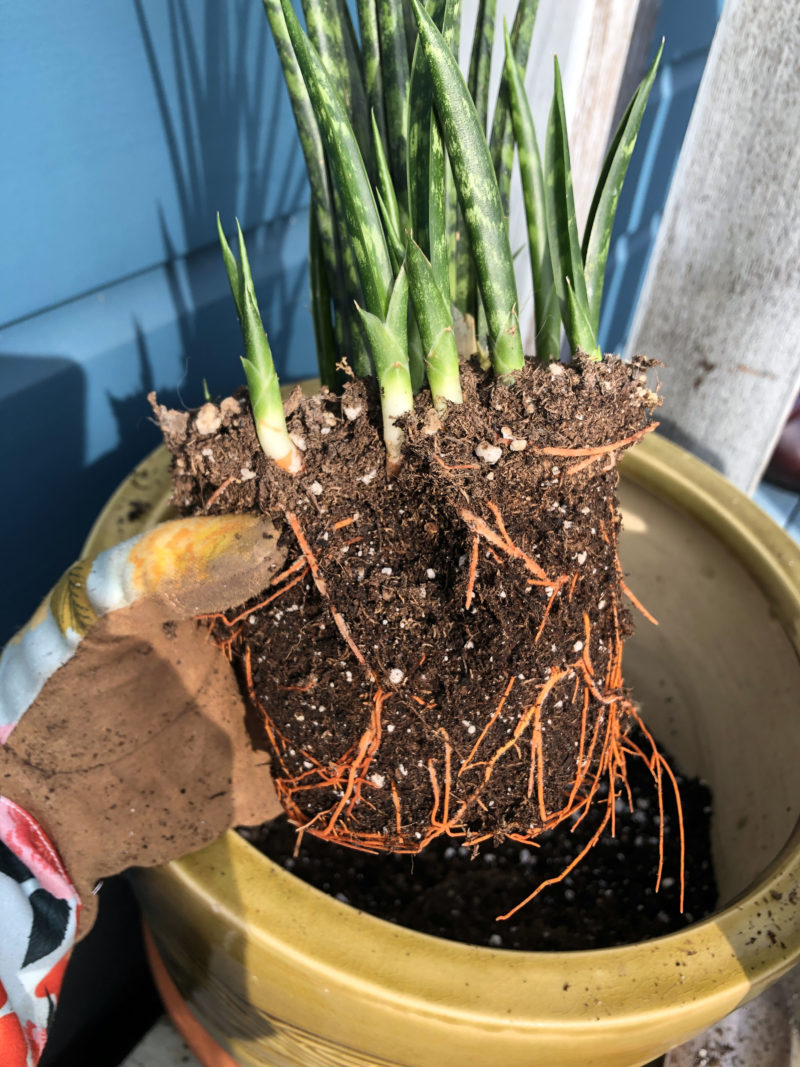Black Coral snake plant is a variety of Sansevieria trifasciata [san-se-VEER-ee-uh, try-fask-ee-AH-tuh].
Unlike the usual bright-colored snake plant, the black coral snake plant is darker in color.
This is perfect if the walls of your house are brightly colored…
then combined a little darker by using a black coral snake plant.
The black coral snake plant will stand out from other decorative.
Before we start, let’s hear to Linda’s story
I have many snake plants at home.
Because with the snake plant, the snake plant can purify the oxygen in my house.
That’s why I have many snake plants at home, however, on a trip to the plant shop.
I see the snake plant is darker in color.
I was surprised because, as far as I know, the snake plant is always bright.
I asked, is this really a snake plant?
Yes, the seller said this is indeed a snake plant, to be more precise, a black coral snake plant.
I was surprised, and it turns out there is this variant.
I bought it and made decorations in my house.
The treatment is the same, and no special treatment is needed.
The black coral snake plant makes me even more special.
Now, let’s back to topic…
Sansevieria Trifasciata ‘Black Coral’
Botanical Name — Sansevieria trifasciata ‘Black Cora Snake Plantl’
Common Name — Black coral snake plant, mother-in-law’s tongue, viper’s bowstring hemp
Plant Family — Asparagaceae
Background
A semi-tropical plant of West Africa..
..Sansevieria trifasciata ‘Black Coral’ grows along roadsides where it originates.
Where it grows naturally, it occurs in open grasslands.
Viper’s bowstring hemp spreads rapidly via creeping rhizomes…
…which can grow just below ground or just above the surface of the soil.
The tough plant fibers were used to construct bowstrings.
Keep reading…
Many people choose to have this plant as a houseplant due to its low-maintenance care requirements.
Its low-light tolerance and the fact that it requires infrequent watering…
…make it an excellent choice for people who frequently travel or who live in low-light environments.
This plant was proven to be effective in removing environmental toxins such as…
…benzene, formaldehyde, and xylene by the NASA Clean Air Study.
“If you have a garden and a library, you have everything you need.”
Marcus Tullius Cicero, a Roman statesman, lawyer, scholar, philosopher and Academic Skeptic
Next is important for you…
Growth Requirements
Sun

Plants of the Sansevieria ‘Black Coral’ family are highly tolerant and adaptable.
They thrive in bright indirect sunlight or in dappled shade..
..and they will even thrive in hours of direct sunlight.
Although black coral snake plants grow best in bright sunlight..
..they are quite tolerant of low light too.
Morning or evening sun is best..
..as sunlight in the afternoon can burn or bleach the leaves.
Due to their efficiency, they are commonly installed in offices and other dark spaces where there is a lack of light.
Temperature/Humidity

Since they are native to tropical environments…
…Sansevieria trifasciata can tolerate moderate amounts of humidity though they do not require it.
They thrive in temperatures between 70 and 90 degree Fahrenheit.
Humidity increases the need for plants to be watered, making them less dependent on irrigation.
Water Black coral snake plants are highly drought tolerant plants.
The black coral snake plant prefers to be watered thoroughly but infrequently.
When watering, be sure to fully saturate the soil and let it dry out completely between waterings.
Wait a few days before watering your black coral snake plant..
..if you aren’t sure whether or not the soil has sufficiently dried.
Those plants thrive on neglect, and over-watering leads to death.
When you are frequently away from home due to travel or a forgetful individual…
…black coral snake plants make a great plant for you!
Soil or Roots

It is best to use a loose, well draining mix for these plants.
A good quality cactus or succulent mix is perfect.
It is fine to use regular potting soil..
..though now you have to remember that…
…it is typically more moisture-retentive, which means…
…you need to adjust your watering schedule based on how well your soil holds moisture.
Additions of pumice stone, perlite, and orchid bark can help ensure better drainage of the soil…
…and can be added up to 50%.
Flowering

Even though black coral snake plants are flowering plants..
..they rarely bloom when grown inside the house.
The inflorescence is a stalk that bears small, greenish-white, sweet-smelling flowers.
Fertilization

The Sansevieria does not require much fertilization.
However, in the spring and summer seasons..
..when the plants are actively growing…
…they do need a light boost of nutrients.
You should use a quarter to half strength fertilizer with a balanced fertilizer.
Propagation
Almost any black coral snake plant can be propagated..
..either by cutting leaves from live plants or through micropropagation.
By cutting the leaves cut them into segments..
..and allowing them to callous for few days.
It will be much better if you can keep the calloused cutting in a very lightly moist microclimate…
…and also if you can provide moisture to it in a humid microclimate.
It can take several weeks to several months for black coral snake plants to root and produce offsets…
…depending on the conditions you provide them with.
Snake plants tend to be slow growers..
..so patience is a must when propagating these.
In addition, division can be a better way to propagate these plants…
…since Sansevieria reproduces asexually via underground rhizomes that produce offsets.
The offsets, also known as pups, can be removed and potted in their own container…
…using a clean knife or garden spade.
If you are dividing a snake plant, you need to let the rhizome callous over for a few days…
…before potting into fresh potting mix.
Keep the soil lightly moist or provide an environment that encourages root growth.
Keep reading…
Health
Diseases

Plants of the snake plant genus are robust and rarely fall victim to diseases or pests.
A scale infestation can be one of the most problematic for these plants.
Scale can be aggressive and destructive..
..but it can be controlled effectively by treating the plant twice a week…
…with a diluted neem oil solution until the scale is eliminated.
Leaf spot is another issue that can plague snake plants.
For small-scale scale infestations..
..it is good to use rubbing alcohol on a Q-tip to physically remove the pests.
A brown or mushy spot can appear along the stem of plants infected by this disease..
..typically caused by a fungus.
Affected leaves should be removed to prevent the spread of the disease.
Maintenance

The plants require very little maintenance to stay healthy and happy.
They prefer to be root-bound so can live in the same pot for several years before repotting.
As a rule of thumb, these plants need to be repotted in new pots every two or three years…
…in a container that is 2”-3” wider than the plant.
Keep going…
Toxicity

Plants are toxic to humans and pets if ingested.
If swallowed, they can cause nausea, vomiting and diarrhea.
These plants should be kept away from children and pets.
So…
Sum Up
Basically, the black coral snake plant is the same as the usual snake plant.
The treatment is the same.
And also has the same benefits.
In addition, the black coral snake plant must also be kept away from pets because it is toxic.
The black coral snake plant is perfect as a decoration in your home that has a bright appearance with dark accents.
Conclusion
Do you already have a black coral snake plant at home?
What do you think, do you prefer the black coral snake plant or just the snake plant?
Leave your feedback in the comments…
Check out more of our posts like this one here!
I hope you can now take care your snake carefully and grow it big!
Thanks for reading this article! Bye!

